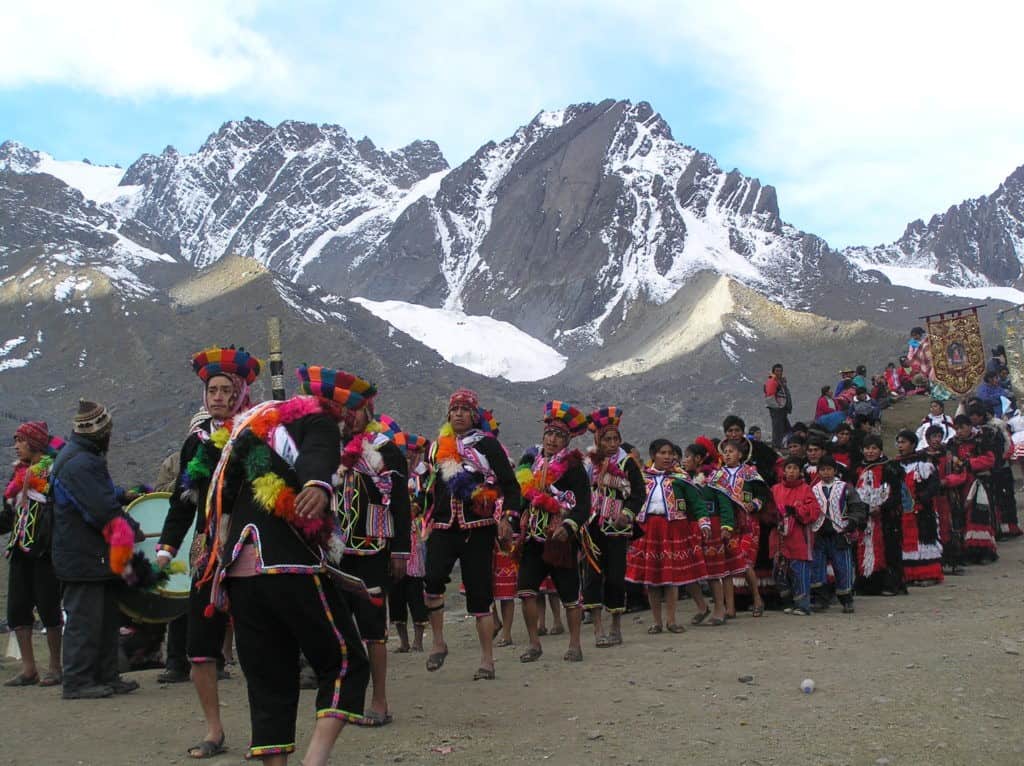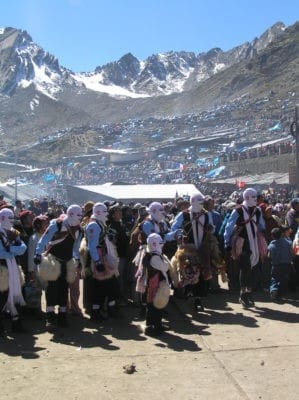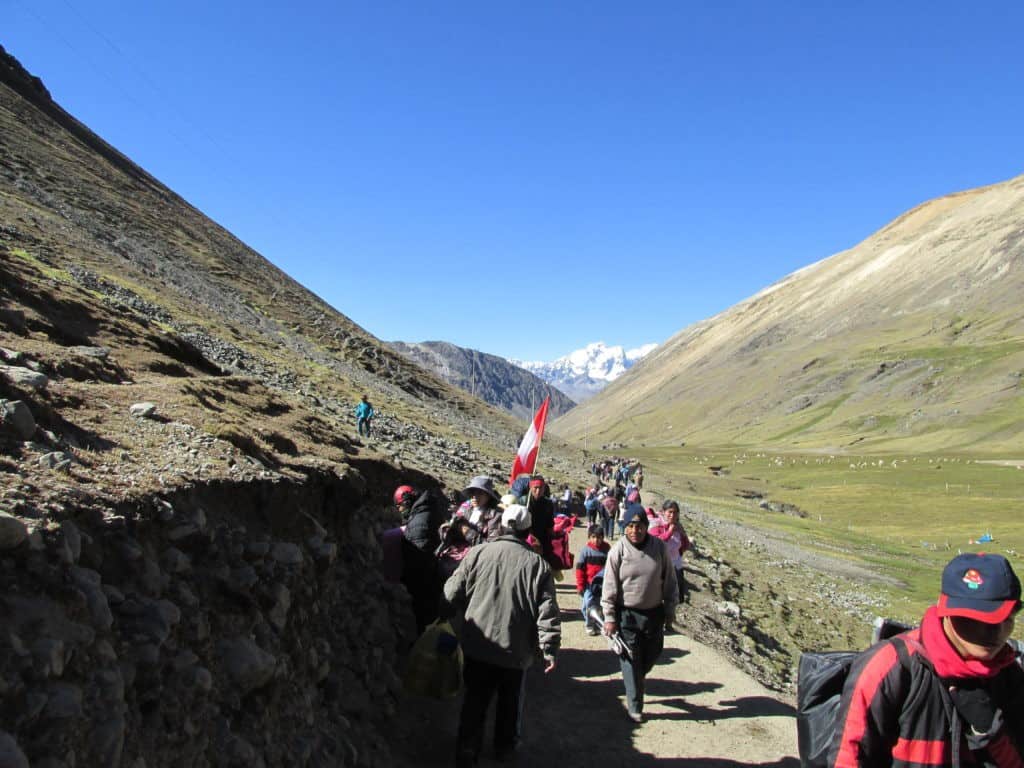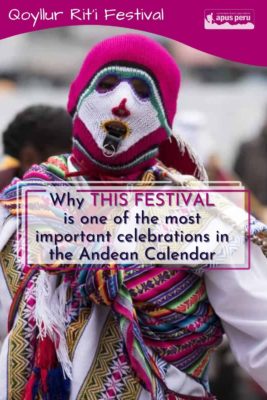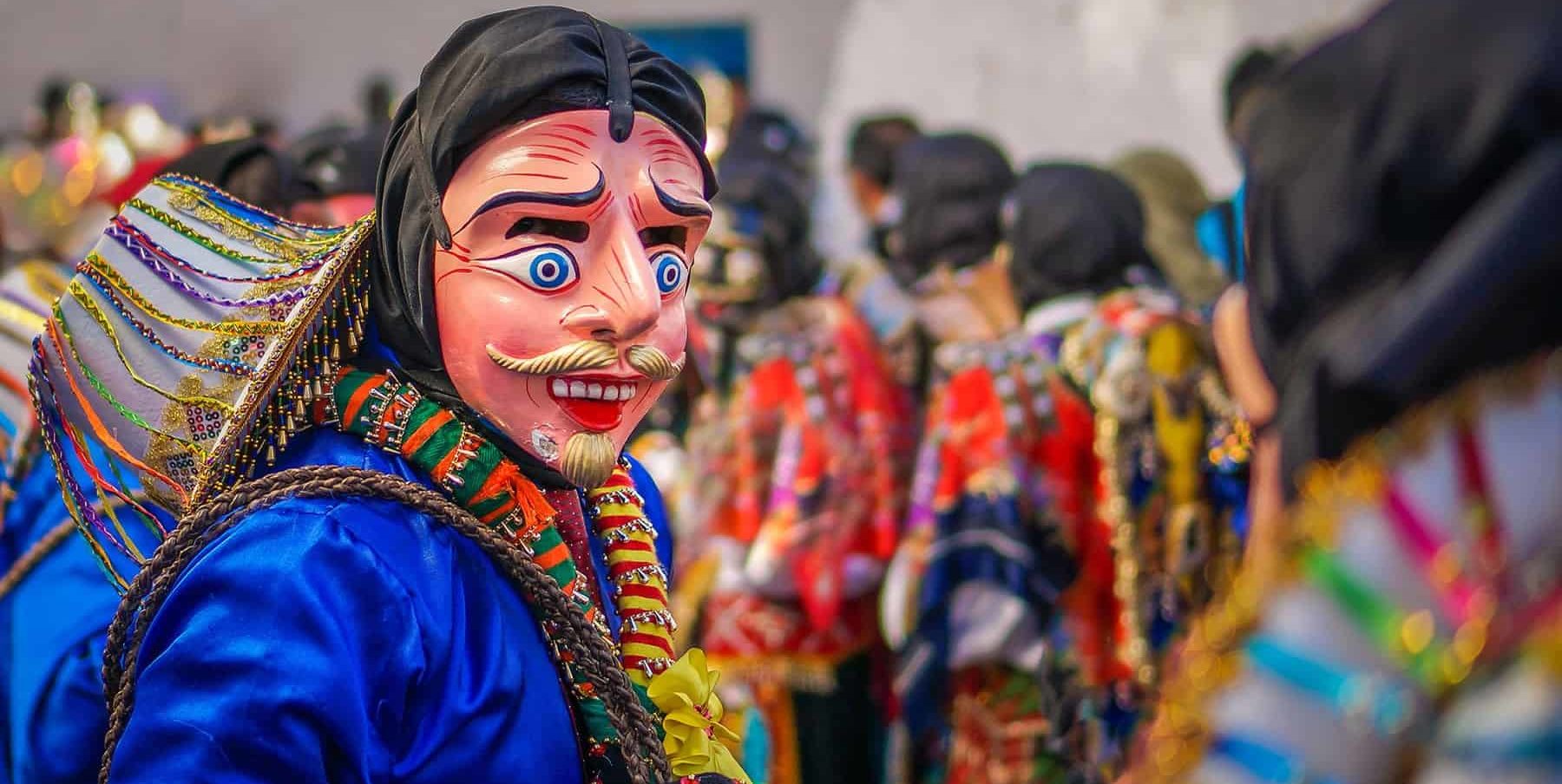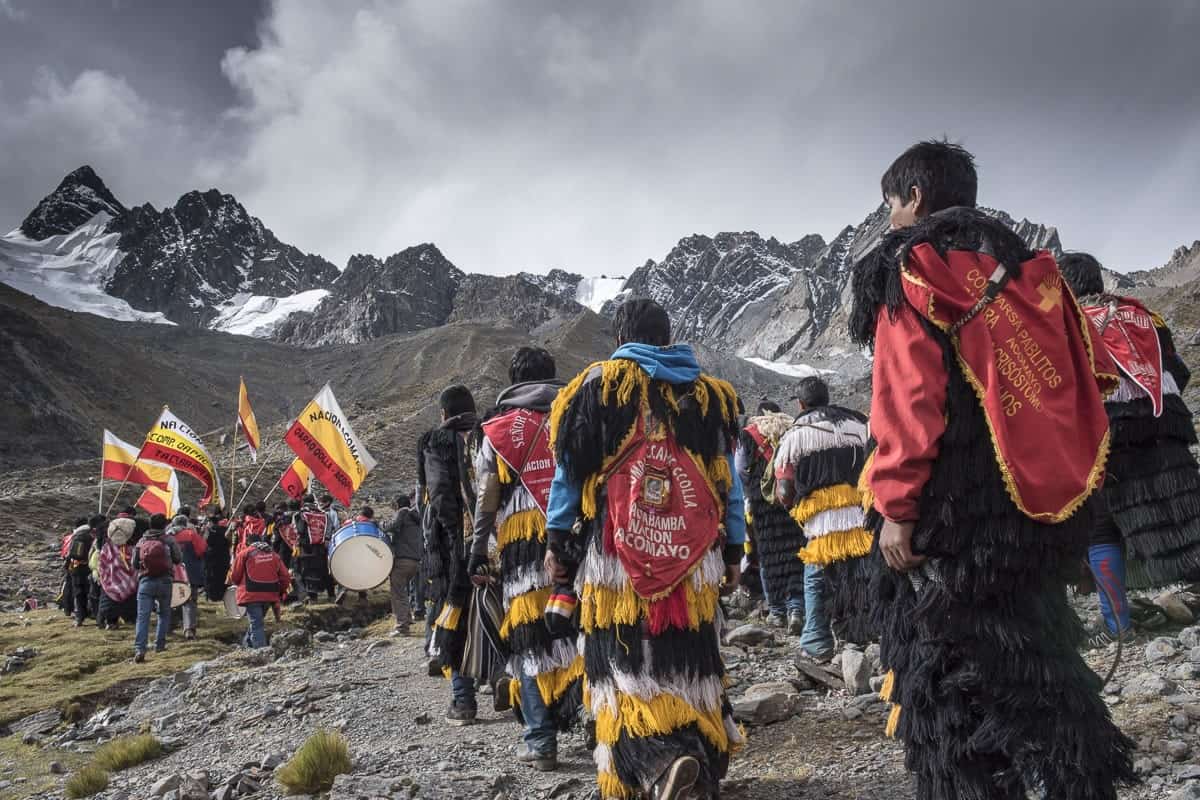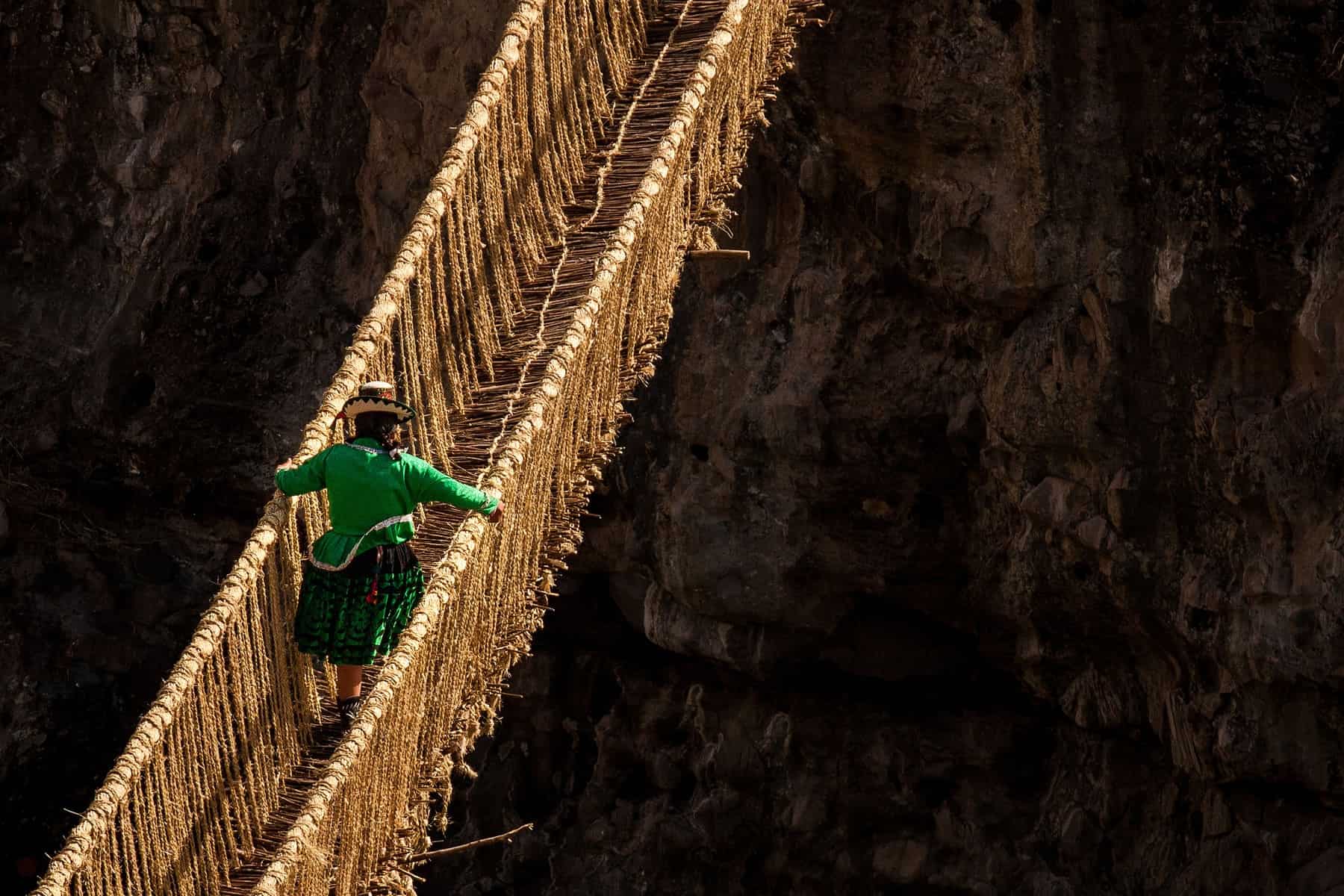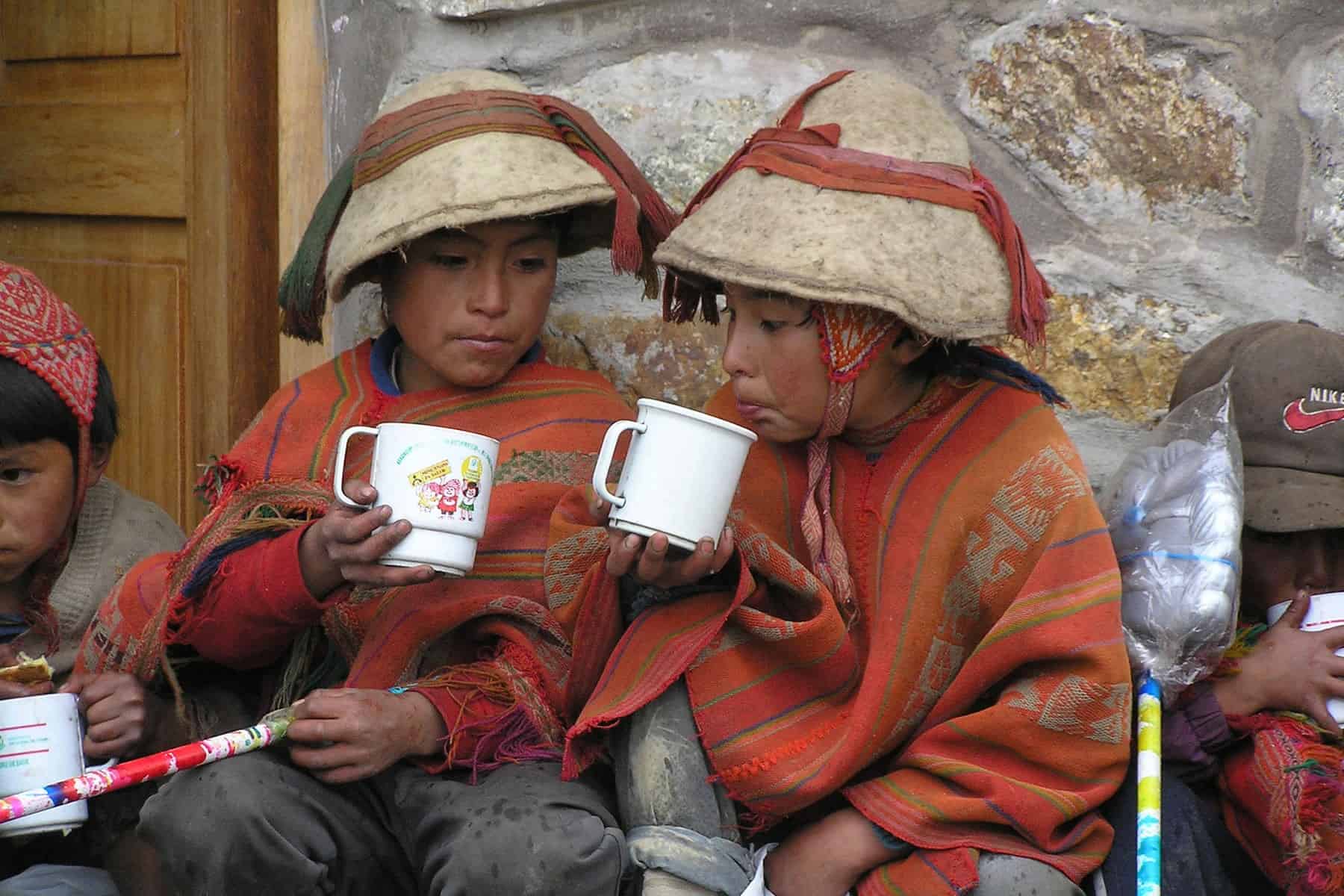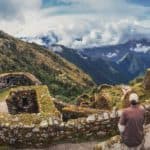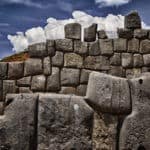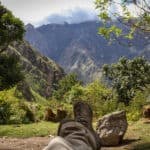Is there anything that sounds more enchanting than a snow star festival? Especially when you know it’s held in Peru and comes with a healthy dose of dancing and fireworks. The Qoyllur Riti celebrations blend Catholic and Andean beliefs whilst invoking celestial spirits for what might just be the most colourful knees-up in South America. Each year, 100,000 pilgrims hike to Mount Sinakara to take part in the largest indigenous festival on the continent.
The famous Peru festival of Qoyllur Rit’i is one of the most important celebrations in the Andean calendar. Devoted to dance and religion, the cultural pilgrimage to the Chapel of Señor de Qoyllur Rit’i has only ever been witnessed by a handful of intrepid adventurers. This is a hidden kingdom where the ancient mountains throw a protective embrace around the Indigenous communities of Peru, and where walking under the gaze of the full moon is all in a night’s work for the dedicated worshipers.
Do you want to join our Qoyllur Rit’i pilgrimage this year? The trek departs once a year only, just days before Corpus Christi is celebrated in Cusco. To celebrate the 2024 Qoyllur Rit’i Festival on our two-day trek, we depart the 26th, 27th or 28th of May. You can then participate in the Corpus Christi festivities on June 8. Contact our friendly travel experts for more personalised attention.
Want to join the pilgrims? Experiencing Qoyllur Rit’i is an incredible opportunity for anyone visiting Cusco and we can take you there! If you’re planning to travel to the region for Corpus Christi, just arrive a week early and join us on one of our Qoyllur Rit’i treks.
What is the Qoyllur Rit’i Festival?
The fiesta Qoyllur Riti is a religious pilgrimage to a remote site in the Ausangate region culminating in three days of dancing, worship, and prayer. Often translated from Quechua as “Snow Star”, the true Qoyllur Riti meaning refers to the first star that appears at night, which just happens to be Venus.
Qoyllor means the first rising star, and rit’i means snow. Combined, the term Qoyllur Rit’i describes the visual phenomenon of Venus resting on top of the glacier as it ascends above the mountain. Worshipers pray to the celestial spirits for the health of their animals and a good harvest. It’s moving to witness, and you can’t help but be swept along with the fervour.
Qoylloriti represents an intriguing blend of religion, with both Spanish and Indigenous elements taking centre stage. Locals venerate Andean mountain gods, or Apus, and parade Catholic crosses across the valley, with ceremonies from both religions continually taking place.
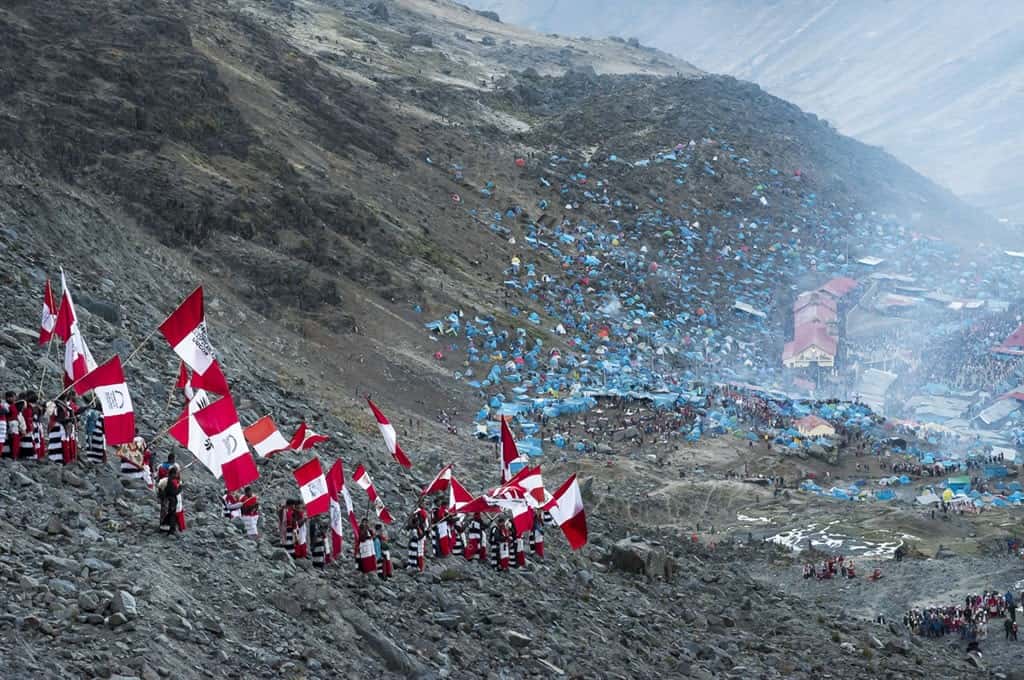
The Origins of the Qoyllur Riti Festival
It’s thought that the Qoyllur Rit’i Festival may have been around even before the Incas made an appearance; at the very least, it pre-dates the Spanish conquistadores. That this unique snow star festival in Peru is still going strong today is a testament to the traditions that have remained central to indigenous life through the centuries. It doesn’t get much more authentic than this!
The Qoyllur Rit’i pilgrimage began as a way of celebrating the stars and specifically the mid-winter disappearance of the Pleiades constellation, followed by its reappearance in the southern skies. This celestial transition marks the journey from old to new and is largely associated with the forthcoming harvest.
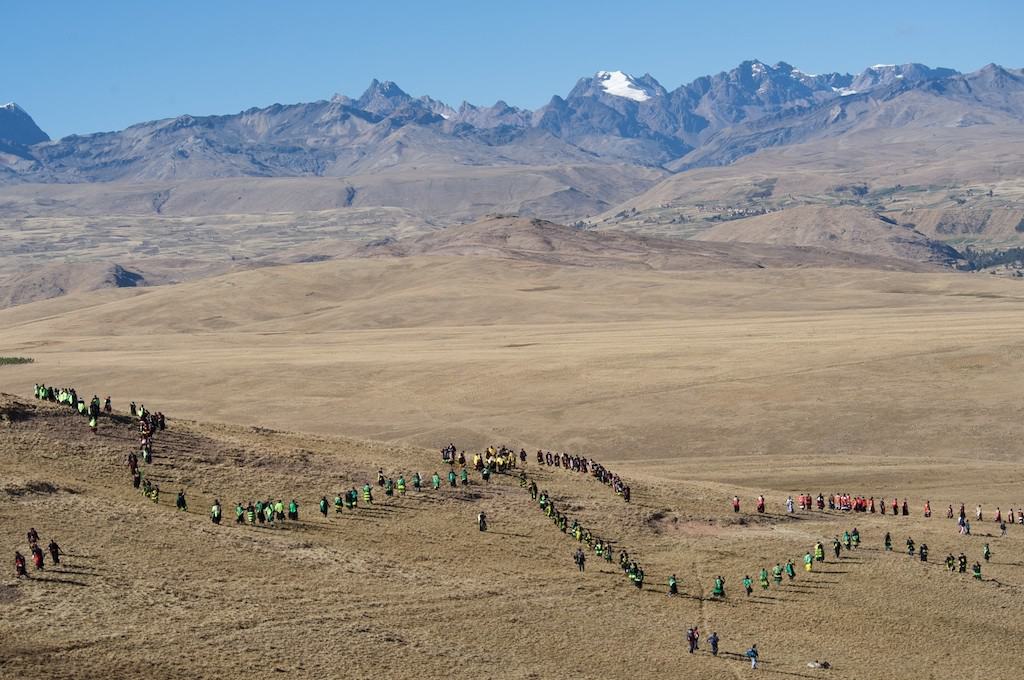
In later years, the arrival of Christianity put a new slant on the legend of the Lord of Qoyllur Rit’i, with a tale involving a boy, a shepherd, and a rock. The story begins with a mysterious fair-haired boy helping a young shepherd care for his alpacas. Hearing about this act of kindness, the Bishop of Cusco decided to find out who the little helper was. Yet the boy had disappeared. No one ever saw him again and the shepherd died of sadness. Sometime later, a miraculous image of Christ appeared etched in a rock at the original meeting place, and this is where you’ll find the Temple of the Lord of Qoylloriti today.
Whatever you prefer to believe, you can’t fail to be moved by the snow star festival. Peru is so much more than hiking the Inca Trail and visiting Machu Picchu. Experiencing a sacred celebration with both Andean and Catholic religious beliefs gives a deeper appreciation for Peruvian culture than anything else you’re likely to do during your trip.
What to Expect at the Qoyllur Rit’i Festival?
The Qoyllur Rit’i Festival has to be seen to be believed. If you can imagine thousands of Indigenous Peruvians, all dressed in striking traditional costumes, gathering in an Andean mountain sanctuary, then you’re halfway there! The valley beneath Mount Sinakara is awash with tents and vendors, with a long line of believers snaking across the slopes as people wait for their turn to enter the church.
You’ll start to notice the build-up to the event during your own pilgrimage to the Sinakara Valley. Along the way, nine crosses mark each kilometre of the route, where pilgrims stop to pray and light candles. On arrival at the sanctuary, these dedicated individuals begin an inauguration ceremony and purification bath, dancing through a circuit of sacred sites. This allows them to enter the spiritual dimension where the energies of deities and men meet. The goal is to reach the Chapel of the Señor de Qoylloriti (the Lord of Qoylloriti, or Taytacha Qoylloriti in Quechua).
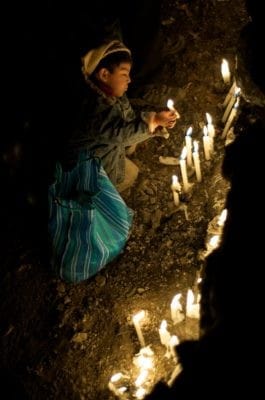
The celebrations last for three days and nights, with non-stop singing, dancing, and praying being the main spectacles. Bands blast out musical tributes, and rockets and fireworks send explosive messages to the heavens, making this one of the most eye-catching fiestas in Peru. Snow stars and gunpowder are the way forward!
After all the jollity has subsided, rather than collapsing in an exhausted heap, the revellers undertake a final pilgrimage, this time under the light of the full moon. Devotees carry heavy wooden crosses in a last procession up the mountain slopes and high passes – not the easiest thing to do at 5,000m (16,404 ft)!
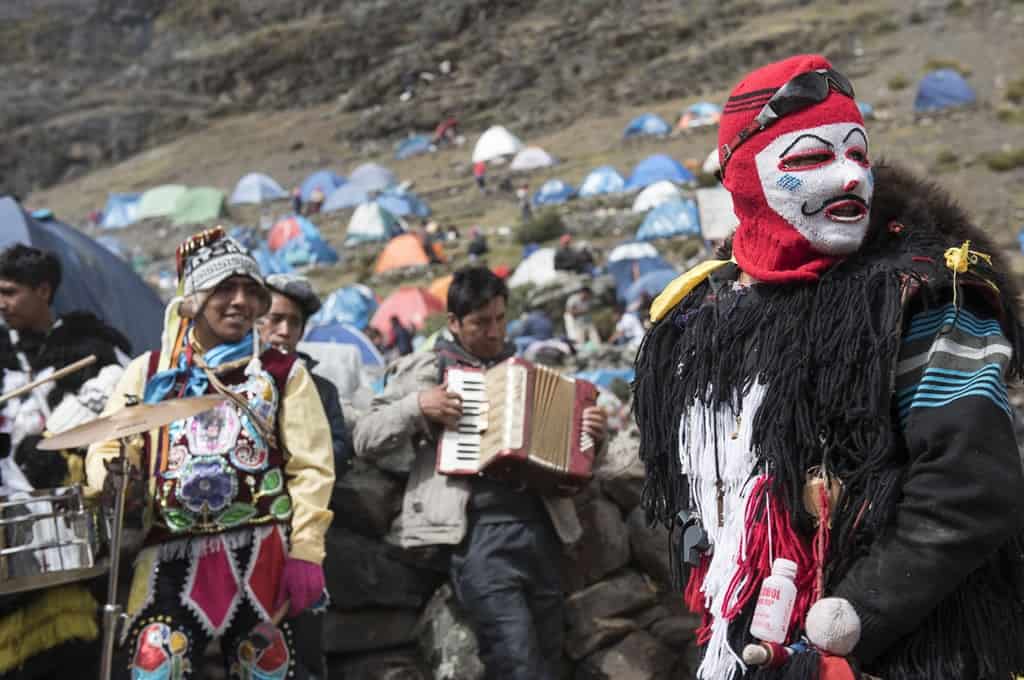
The Essential Components of Qoyllur Rit’i
So, you now know what to expect at the festival, but just who are the different dancers and what’s with the miniature cars and bush tucker style grub?
The Comparsas
Local villages send costumed delegations, known as comparsas, to the Qoyllur Rit’i Festival where they dance and pray. The Ten Nations (or ten brotherhoods) that belong to the Paucartambo, Qusipicanchis and Tahuantinsuyo provinces all attend the event. The participant masses make their way to Mount Sinakara where simulated battles result in all the brotherhoods banding together, making this a very special and lively show.
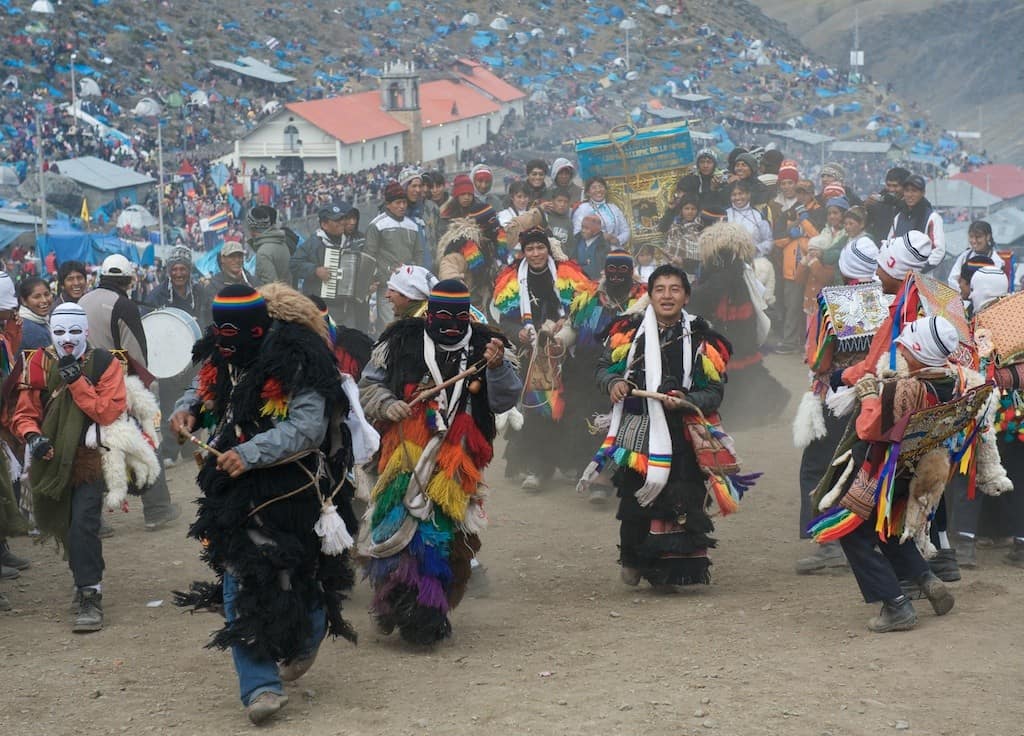
The Ukukus
On their journey to the Sinakara Valley, the ukukus join the comparsas. Also known as pabluchas or pablitos, these shaggy dancers dressed as bears are here to protect Señor de Qoyllur Rit’i and uphold his laws. Anyone caught disrespecting the rules by drinking alcohol or not removing hats during prayers will receive a stern talking to. Sometimes, the ukukus may even whip repeat offenders!
The ukukus carry alpacas and act as intermediaries between the people and the Tatyacha Qoyllur Riti, Lord of the Snow Star. Their ritual begins at 4 AM with a climb to the Sinakara Glacier, and prayers to ask for the continued health of their livestock. Traditionally, these guardians would return to the valley with an ice block from the glacier which they used to purify the people. Today, thanks to climate change, performers do not practice this ritual anymore.
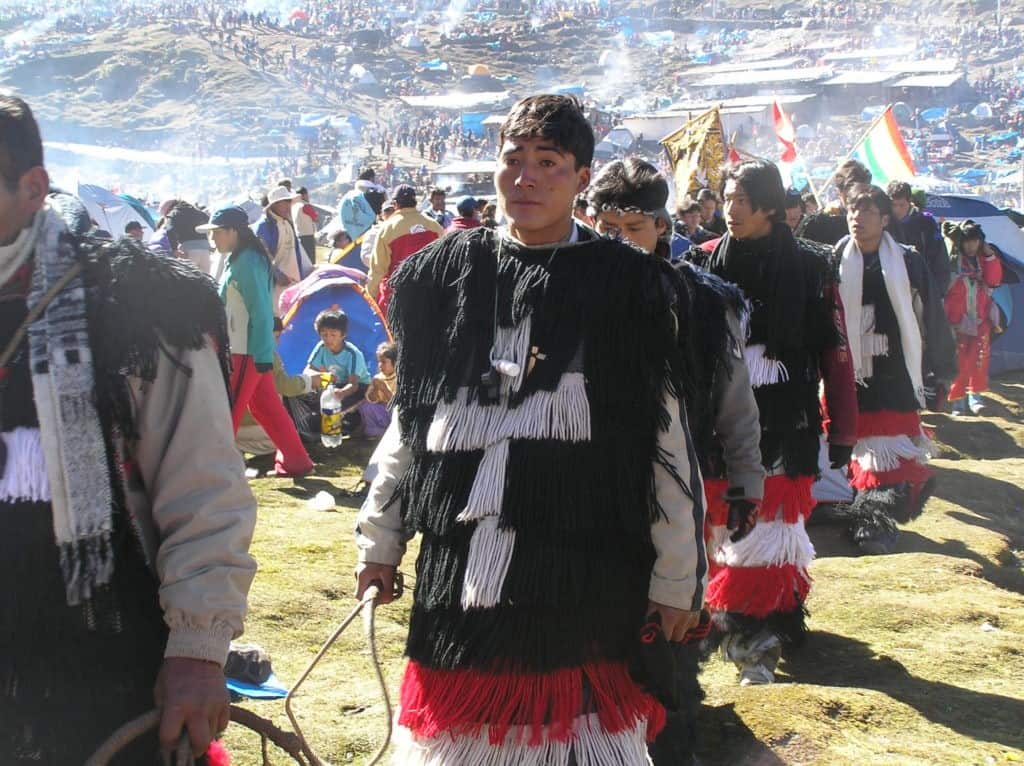
The Alacitas Market
Many people making the Qoyllur Rit’i pilgrimage buy offerings at the alacitas craft market of miniatures, which has everything from tiny cars and houses to wedding scenes. The belief is that on their fourth visit, El Señor de Qoyllor Rit’i will make the wishes of the devout come true!
The Food
Visiting a Peru festival is a great way to taste some of the most authentic food that the country has to offer. You won’t find tourist menus here! Favourites at the fiesta Qoyllur Riti include staples like chicharrónes (fried pork), lomo saltado (sautéed beef), and chicha morada (a purple corn drink) with a few more unusual dishes to tempt curious gourmets out of their shells. Donkey head stew anyone? You can go a step further with a beaker of the famous frog smoothie, and yes, it’s exactly like it sounds!
Attending the Qoyllur Rit’i Festival with Apus Peru
First things first, it’s important to realise that the Qoyllur Rit’i pilgrimage isn’t for the faint-hearted. It’s not the sort of place where you rock up with your picnic blanket and settle in for the festivities, and indeed, it’s the effort required to get there that puts a little extra shine on the experience.
This incredible adventure is reserved for those seeking a privileged glimpse into an age-old tradition, one that is most likely disappearing as fast as the glaciers. The Qoyllor Rit’i trek is filled with challenges, both physical and cultural. You will share another world with the indigenous people of Peru for some intense days of hiking and devotion, yet in exchange for the hardships, you will have an experience that touches the soul like nothing else ever has!
Apus Peru is one of the only trekking companies that can facilitate a visit to the Qoyllur Rit’i Festival during a tour of the Cusco area, combining hiking with a generous helping of spiritualism. If you’re looking to do something a bit different on your trip, then this ticks all the boxes!
Whilst all our off-the-beaten-path Peru treks plunge you right into the heart of Andean culture and the traditional way of life here in the mountains, nothing else comes close to the thrill of attending Qoyllur Rit’i.
Preparing for a Qoyllur Riti Trek
If you’re planning to attend Qoyllur Rit’i, there are a few things to consider. The Qoyllur Riti altitude is around 4700m (15,420 ft), so you do need to acclimatise in Cusco for a few days beforehand. Of course, this is no hardship as Cusco has truly earned its place as the heart of the Inca Empire, and there are plenty of treks and sightseeing tours to enjoy using the city as a base.
You also need to be prepared for the cold! Temperatures plummet in the valley at night, so having the right kit is essential. Something else to consider is that the whole experience may be a bit of a culture shock, which is no bad thing if you go with an open mind and just take everything in your stride. It will be emotional, profound, and even a little surreal, which is precisely the reason you are here!
When is Qoyllur Rit’i held?
Qoyllur Rit’i takes place every year during the lead up to Corpus Christi. This means that the festival can be either in May or June, depending on when Easter and Corpus Christi fall. Our special Qoylloriti tours depart the Sunday prior to the Corpus Christi Thursday, so factor this in when planning your visit.
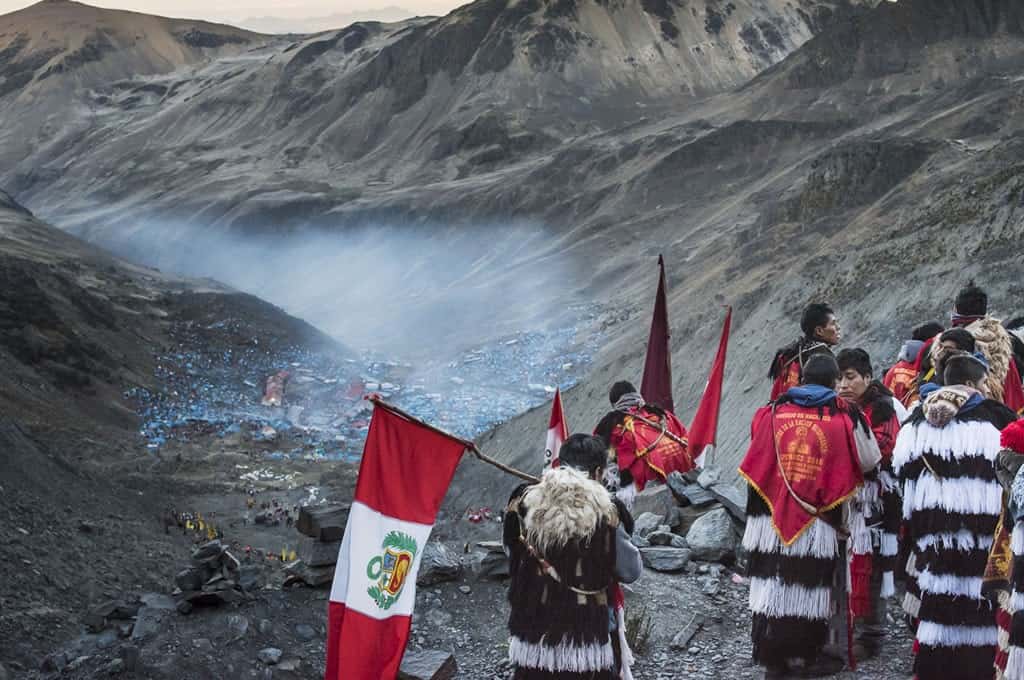
Where is the Qoyllur Rit’i Festival?
As you’d expect from a celebration named the “Snow Star Festival”, Qoyllur Rit’i takes place high in the Peruvian Andes. Surrounded by twinkling night skies and snow-dusted mountain peaks, the Sinakara Valley makes a magnificent backdrop, especially when flooded with the colours of Indigenous clothing worn by the thousands of pilgrims camped out across the slopes. Apu Ausangate is nearby too, so you know that you’re truly in the presence of the mountain gods.
To reach the festival you’ll drive south from Cusco for about three hours, heading towards Mahuayany. There will be plenty of photo stops along the way, with Urcos and Ocongate being particular highlights. Then it’s time for the 8km (5 mi) trek to the Qoyllor Rit’i Sanctuary, which takes between 3-5 hours on a steady uphill trail. You’ll camp overnight alongside thousands of other pilgrims, putting you right in the heart of the action!
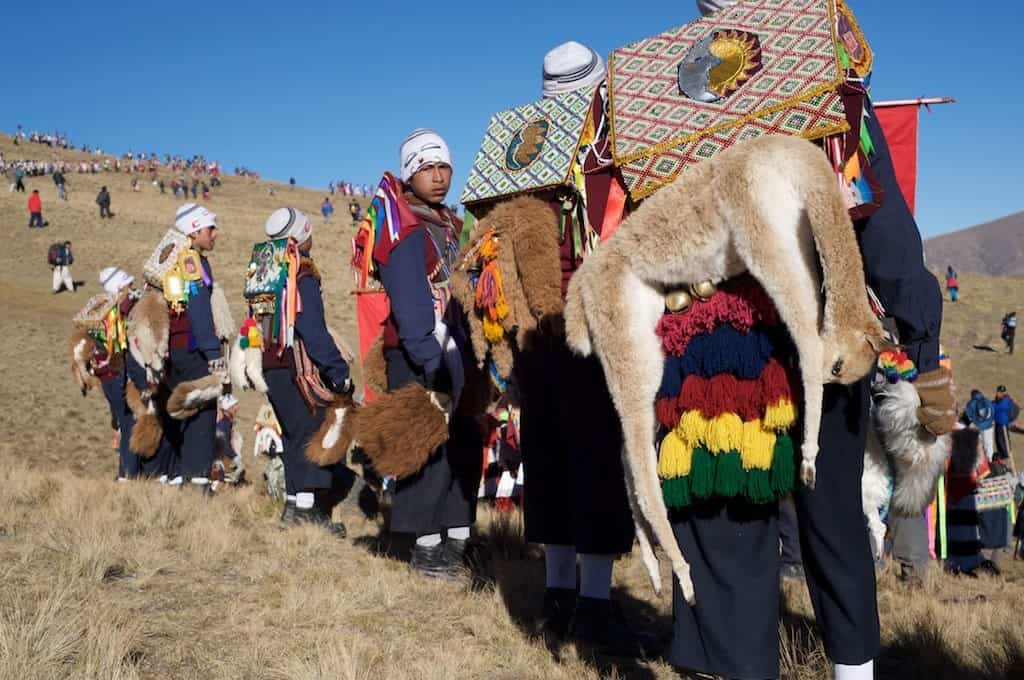
What to Bring
As you’ll be going on an overnight adventure into the Andes, you should prepare just as you would for any other mountain trek. Check out our packing guide for more details.
Thanks to the Qoyllur Riti altitude, you’re going to get very cold at night, so make sure you pack plenty of warm clothing, including thermal layers, hats, and gloves.
If you’re hiring a sleeping bag rather than taking your own, try and get one that will keep you toasty at minus temperatures.
Don’t forget to pack a spare battery or portable power pack for your camera, as you’ll definitely be wanting to photograph the celebrations! Whilst it will be impossible to seek permission from everyone when you want to take photos, do be discreet, and respectful of those around you – always ask if you’re taking close-ups.
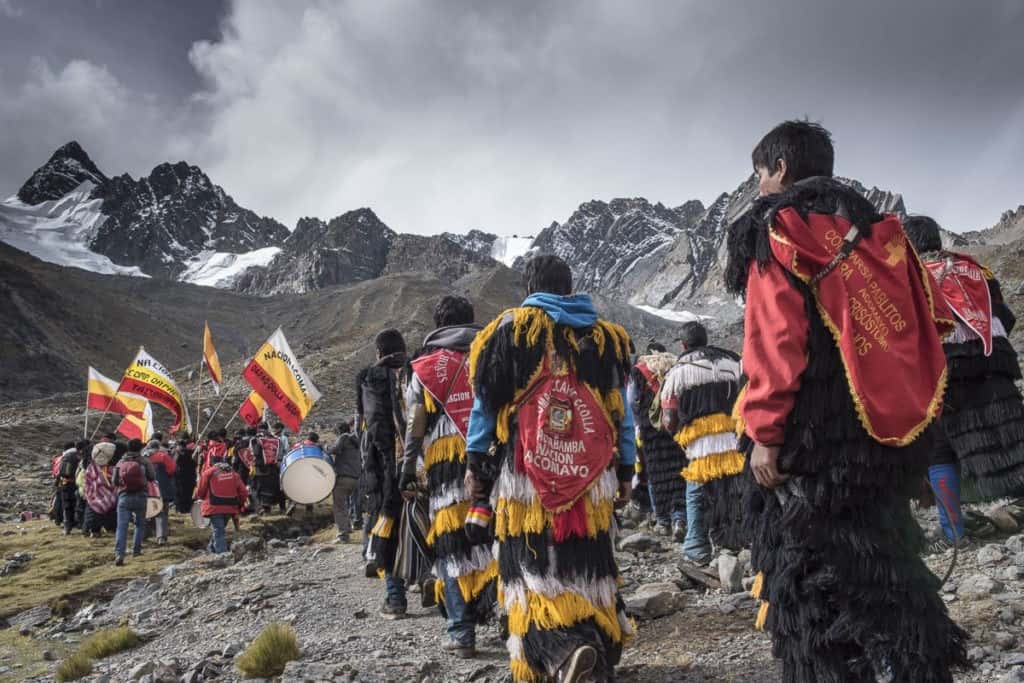
Qoyllur Rit’i and Climate Change
Although the celebratory traditions have held fast through the centuries, there is one element that has been recently altered at the snow star festival. Peru, like everywhere else in the world, hasn’t been immune to climate change and has sadly lost nearly 30% of its glaciers over the past couple of decades.
As ice continues to recede, the sacred Sinakara Glacier no longer plays a ceremonial role in the Qoyllur Riti festival celebrations, and the pilgrim nations have stopped carving blocks of ice to take back to their communities.

Insider Tip: Want to sound like a local? Then practice getting your tongue around Qoyllur Rit’i – and try its pronunciation; “coil-yure-ree-tee”. As Quechua is a largely verbal language, you are likely to see Qoyllur Riti spelt in any of the following ways: Qoylloriti/Qollority/Qoyllur Rit’i/Colloritty. Read more about the Quechua language here!
It’s Time to Reach for the Stars!
If all this talk of snow and stars has piqued your interest, then have a chat with us and see if you can incorporate the Qoylloriti Festival into your plans. Camping amongst Indigenous pilgrims in a beautiful Andean Valley and witnessing sacred rituals by the light of the full moon is sure to trump just about anything else you’re likely to do in Peru.
Inspired to do this yourself? We offer truly unique, amazing 2-day and 4-day Qoyllur Rit’i tours.
Nearly everyone visiting the country conquers the Inca Trail, but hardly anyone takes in Qoyllur Rit’i. If you want to experience something unusual and exclusive in Peru, snow and stars included, then make a date with the Sinakara Valley and let us show you a side to the country that few other visitors have ever seen.

